Getting Started With Zephyr: Devicetrees
This blog post provides an introduction to the "Devicetree", another unique concept in The Zephyr Project. We learn about the basic syntax of a device tree and how its structure and hierarchy mirror hardware, from the SoC to the final board. We also see how hardware described in a devicetree can be referenced and controlled in the source code of a Zephyr-based application.
NULL pointer protection with ARM Cortex-M MPU
This post explains how you can set up the ARM Cortex-M MPU (Memory Protection Unit) to protect thy code from dragons, demons, core dumps, and numberless other foul creatures awaiting thee after thou dereference the NULL pointer.
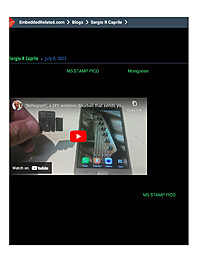
Bellegram, a wireless DIY doorbell that sends you a Telegram message
A wireless button that uses the M5 STAMP PICO and Mongoose to send a Telegram message when pressed. The code is written in C
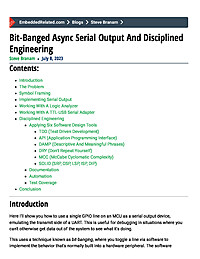
Bit-Banged Async Serial Output And Disciplined Engineering
This post covers implementing asynchronous serial output directly on a GPIO with bit-banging. This can be a valuable debug tool for getting information out of a system. It also covers disciplined engineering, using the bit-banging module as an example and template you can apply to other projects.
Getting Started With Zephyr: Kconfig
In this blog post, we briefly look at Kconfig, one of the core pieces of the Zephyr infrastructure. Kconfig allows embedded software developers to turn specific subsystems on or off within Zephyr efficiently and control their behavior. We also learn how we can practically use Kconfig to control the features of our application using the two most common mechanisms.
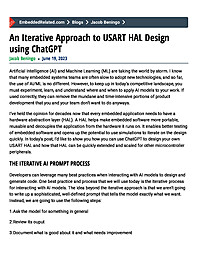
An Iterative Approach to USART HAL Design using ChatGPT
Discover how to leverage ChatGPT and an iterative process to design and generate a USART Hardware Abstraction Layer (HAL) for embedded systems, enhancing code reusability and scalability. Learn the step-by-step journey, improvements made, and the potential for generating HALs for other peripherals.

Modern C++ in Embedded Development: (Don't Fear) The ++
While C is still the language of choice for embedded development, the adoption of C++ has grown steadily. Yet, reservations about dynamic memory allocation and fears of unnecessary code bloat have kept many in the C camp. This discourse aims to explore the intricacies of employing C++ in embedded systems, negotiating the issues of dynamic memory allocation, and exploiting the benefits of C++ offerings like std::array and constexpr. Moreover, it ventures into the details of the zero-overhead principle and the nuanced distinctions between C and C++. The takeaway? Armed with the right knowledge and a careful approach, C++ can indeed serve as a powerful, safer, and more efficient tool for embedded development.
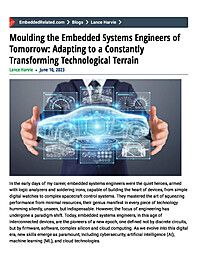
Moulding the Embedded Systems Engineers of Tomorrow: Adapting to a Constantly Transforming Technological Terrain
Embedded systems engineers, previously focused on device architecture, are now steering the digital era, encompassing firmware, software, complex silicon, and cloud computing. To keep pace, mastery in new areas like cybersecurity, artificial intelligence (AI), machine learning (ML), and cloud technologies is critical. In today's highly connected world, security is foundational to design, necessitating knowledge in encryption, secure coding, and data protection laws. Additionally, expertise in AI and ML is essential for managing vast global data, requiring understanding of ethical implications and effective system design for data analysis. The advent of cloud technology mandates learning about cloud architectures and data security. In this fast-paced field, continuous learning and adapting these new skills is the key to staying relevant and spearheading future advancements.
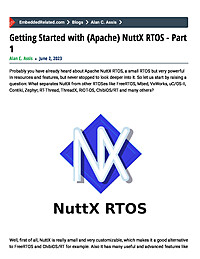
Getting Started with (Apache) NuttX RTOS - Part 1
NuttX RTOS is used in many products from companies like Sony, Xiaomi, Samsung, Google/Fitbit, WildernessLabs and many other companis. So, probably you are already using NuttX even without knowing it, like the you was using Linux on your TV, WiFi router more than 10 years ago and didn't know too! Today you will have the chance to discover a little bit of this fantastic Linux-like RTOS! Are you ready? So, let's get started!
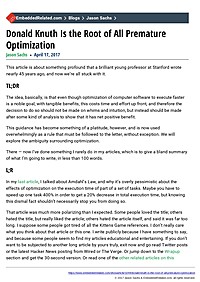
Donald Knuth Is the Root of All Premature Optimization
This article is about something profound that a brilliant young professor at Stanford wrote nearly 45 years ago, and now we’re all stuck with it. TL;DR The idea, basically, is that even though optimization of computer software to execute...
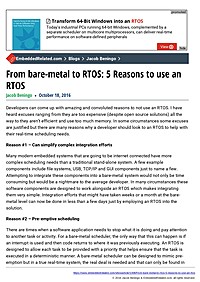
From bare-metal to RTOS: 5 Reasons to use an RTOS
Developers can come up with amazing and convoluted reasons to not use an RTOS. I have heard excuses ranging from they are too expensive (despite open source solutions) all the way to they aren’t efficient and use too much memory. In some...

Lost Secrets of the H-Bridge, Part III: Practical Issues of Inductor and Capacitor Ripple Current
We've been analyzing the ripple current in an H-bridge, both in an inductive load and the DC link capacitor. Here's a really quick recap; if you want to get into more details, go back and read part I and part II until you've got equations coming...
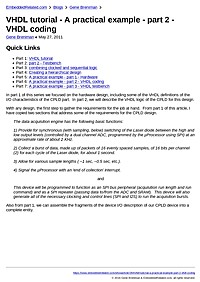
VHDL tutorial - A practical example - part 2 - VHDL coding
[quicklinks]In part 1 of this series we focused on the hardware design, including some of the VHDL definitions of the I/O characteristics of the CPLD part. In part 2, we will describe the VHDL logic of the CPLD for this design. With...

Arduino robotics #1 - motor control
Arduino Robotics Beginner robotics is a series of article chronicling my first autonomous robot build, Clusterbot. This build is meant to be affordable, relatively easy and instructive. The total cost of the build is around $50....
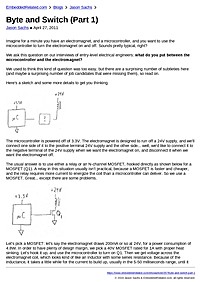
Byte and Switch (Part 1)
Imagine for a minute you have an electromagnet, and a microcontroller, and you want to use the microcontroller to turn the electromagnet on and off. Sounds pretty typical, right?We ask this question on our interviews of entry-level electrical...
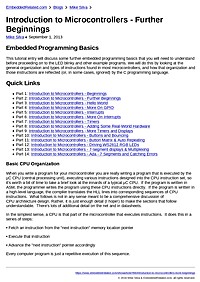
Introduction to Microcontrollers - Further Beginnings
Embedded Programming Basics This tutorial entry will discuss some further embedded programming basics that you will need to understand before proceeding on to the LED blinky and other example programs. We will do this by looking at the...

MSP430 LaunchPad Tutorial - Part 3 - ADC
In this new episode of our journey into MSP430 I will explain the basics of Analog to Digital Conversion on the MSP430G2231.We will write a program that will read an ADC channel and will toggle some leds based on the result of the...

Blinkenlights 2.0
Nothing spells old movie computers like a panel of randomly blinking lights, but in fact, these so-called "blinkenlights" can be valuable indicators - especially in embedded systems where the user interface must be minimal, small and cheap. Control of these lights can be achieved using a very simple, real-time interpreted script, and this kind of solution may be extended to other and more complex embedded tasks.



















